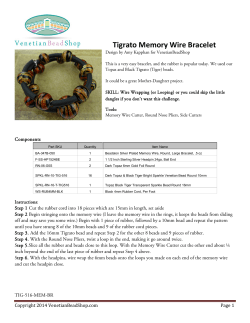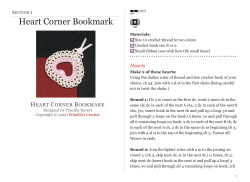
Wire Wrapped Sunburst Earrings Jewelry Making Tutorial
Wire Wrapped Sunburst Earrings Jewelry Making Tutorial Created by Emily Tan Reviewed by XQ Designs www.Handmade-Jewelry-Club.com www.DIYLessons.org www.DiyBeadingClub.com Please do not distribute, lend or copy. Do not mass produce. Copyrights 2012 XQ Designs WIRE WRAPPED SUNBURST EARRINGS Created by Emily Tan of www.emilysecretpassions.blogspot.com Level: Beginner to Intermediate In this lesson, you will learn to create this pair of earrings by learning to construct the frame, wrapping/coiling the loops, attaching the beads and making a pair of ear wires. The techniques you will learn creating this piece can also be used to create pendants. You can create variations by adding beads and embellishing the looped wires to make it more sparkly! You can make it more colorful by using color coated wires. Surely, this earring will make your day sparkly and sunny! Page 1 www.diylessons.org www.diybeadingclub.com www.handmade-jewelry-club.com Materials: 18g wire (work from spool) – construction of frame 20g wire (work from spool) – making loops & ear wires 26gwire (120cm long) – for wrapping/coiling 2 pcs of 15cm coin shape or round flat/puffy beads (drilled from top to bottom). 2 pcs of ear wires (you may use ready-made ear findings or make a pair yourself, as shown in this tutorial) Measurements indicated here are for the type of bead I’ve used. If you use a smaller/larger bead, please adjust the measurements accordingly. Please read thoroughly the whole tutorial before you start cutting the wires. Tools: Chain nose pliers/flat nose pliers Wire cutter Nylon jaw pliers Hammer Steel block (optional) Mandrel with 15cm in diameter (I’ve used a marker pen) Wigjig Ruler PART 1: CONSTRUCTING THE WIRE FRAME WITH LAYER WRAPS. Place the 18g wire (working from spool) on a mandrel. In this lesson, I’ve used a marker pen as the mandrel. Coil the wire around the marker pen to form a round frame. Let the wire overlap each other by about 0.5cm to 1.0cm. If you plan to use a larger bead, a thicker mandrel can be used to form the frame, and if a much smaller bead is used a thinner mandrel is required. Page 2 www.diylessons.org www.diybeadingclub.com www.handmade-jewelry-club.com Slip the wire off the mandrel carefully. Place the bead into the round frame to see whether it fits. Make the necessary adjustments if the bead does not fit by slipping the frame back onto the mandrel. Remove the bead and trim both ends of the wire and leave the overlaying part 1cm as shown. Re-check the fitting of the frame to the bead again until you are satisfied with the fit. You may cut the ends if you find it too long. Page 3 www.diylessons.org www.diybeadingclub.com www.handmade-jewelry-club.com This is how it looks like after adjustment. File both ends of the wire and leave aside to be used later. Place the round frame on the steel block. The overlaying part must not be over each other when hammering (refer to picture) Hammer the frame lightly on the steel block to slightly flatten it. The hammered frame will expand by about 0.2cm. Adjust the overlaying part with flat/chain nose pliers until you get a perfect round frame. Repeat the whole process of Part 1 to make another round frame. Page 4 www.diylessons.org www.diybeadingclub.com www.handmade-jewelry-club.com PART 2: MAKING THE LOOPS WITH WIGJIG Insert the pegs as shown to acquire the figure “8” loops. If you have enough pegs, you may insert them until you get about 13 – 14 loops. Take the 20g wire (work from spool) and make a round loop with your round nose pliers. Ensure that the round loop fit into the 1st peg. Place the loop into the 1st peg, continue to bring the wire down to the 1st bottom peg (as shown) and bring the wire around the peg, up to the next 2nd peg on top, bring it around again and down to the 2nd peg at the bottom. See next picture for a clearer view. This is how the figure “8” loops are formed. Follow the directions of the wire as shown in the pictures below. Continue until you have about 14 loops on either side If you don’t have sufficient pegs, you can start from where you left by taking the loops you’ve made, off from the last peg and re-insert the wire at the 1st peg and continue making the loops until you get 13 – 14 loops (depending on the bead you use) Page 5 www.diylessons.org www.diybeadingclub.com www.handmade-jewelry-club.com Continue making the loops until you have sufficient loops to go round the bead. Take the loops off slowly from the pegs. You can stretch the loops with your fingers to get the desired length and space between the loops. Don’t worry if you have extra loops. This can be trimmed off later. Flatten the loops (optional) with nylon jar pliers. Adjust and re-adjust the length of the loops by stretching the wire with your fingers to get the desired fit around the outer round frame. Follow the process of Part 2. Once you have the loops ready, set it aside. Page 6 www.diylessons.org www.diybeadingclub.com www.handmade-jewelry-club.com Let’s get on with the next step …….. PART 3: WRAPPING FIGURE “8” LOOPS TO THE ROUND FRAME Cut apiece of 26g wire, measuring about 3 feet (90cm) to begin wrapping the loops. Don’t worry …. You have more than enough wire to do the wrapping. Mark the middle point of the frame at the overlaying part (as shown). Begin wrapping the frame at the marked point, leaving about 1” of wire (you can trim it off later). Use the longer wire to wrap about 4 – 5 rounds towards the frame before attaching the figure”8” loops. Note: For a right-handed person, you’ll work in clockwise direction and for left-handed, vice versa. Place the 1st loop against the frame right after the initial wraps and start wrapping 4 – 5 times tightly into each loop and the space between the loops. The number of wraps between the spaces will depend on how far apart you stretch the loops around the frame. Page 7 www.diylessons.org www.diybeadingclub.com www.handmade-jewelry-club.com Neatly wrapped/coiled. Half way done ….. Let’s continue to wrap to the end. Wrap the remaining last loop towards the 1st loop wrapped. At this time, make sure that the last loop aligns with the 1st wrapped loop on the frame. If you have extra loops here, you may trim it off. See how the last loop aligns with the first wrapped loop. Secure the overlapping loops with the remaining wire by wrapping both loops 5 – 6 times. Trim the excess wire with a cutter and press it down neatly with chain nose pliers. Page 8 www.diylessons.org www.diybeadingclub.com www.handmade-jewelry-club.com Front view of the frame. Back view…… as neat as the front. PART 4: ATTACHING THE BEAD Cut a piece of 26g wire, measuring 3 – 4 inches long (for each attachment). Slip the bead into the 26g wire at about half way (as shown) and start wrapping the bead at the top (make sure that the wire is aligned to one of the loops at the top & bottom. Wrap a few times to secure the bead. Trim off any excess wire and press down neatly with chain nose pliers. Use the remaining 26g wire to attach the bead bottom, wrap a few times as you have done with the top. Page 9 www.diylessons.org www.diybeadingclub.com www.handmade-jewelry-club.com Turn the frame around. Now use the remaining 26g wire, start wrapping the back side to secure the bead from swiveling. Bring the wire from behind the round frame up against the bead and wrap it a few times around the frame and the 26g wire itself. Trim off excess wire and press down neatly with chain nose pliers. The bead should rest snugly in the frame. Front view Back view …. Neat and tidy as the front (I am a neat freak!!) Repeat the whole process of Part 4 for the other side. PART 5: MAKING THE EAR WIRES Measure and cut 2 pieces of 20g wire, each measuring 2 inches (5cm) in length. Form a loop of about 4mm diameter at one end of the wire with your round nose pliers. Page 10 www.diylessons.org www.diybeadingclub.com www.handmade-jewelry-club.com I’ve used a jump ring maker as a mandrel to form the U shape for the ear wire. Bend the wire about 1cm from the top of the loop around the jump ring maker. Mark and cut 3cm from the top of the bend. Repeat with the other ear wire. File the wire ends to smoothen. The completed ear wires, ready to be attached to the bead components. Open slightly the loop with the chain nose pliers. Page 11 www.diylessons.org www.diybeadingclub.com www.handmade-jewelry-club.com Attach the bead component to the ear wire and close it. Repeat with the other bead component. Congratulations! You’ve made a pair of earrings all by yourself. You can use some creativity and imagination on how to create some other variations of designs by attaching beads to make it sparkly or leave it simple by attaching a jump ring and a chain to convert it into a pendant. Another variation, using a larger oval bead. You can attach some smaller beads to embellish the outer loops to make it sparkly. If you have any query or feedback for the tutorial, please contact me at diyjewelryclub@gmail.com. Please do not distribute, lend or copy. Do not mass produce. Copyrights 2012 XQDesigns Page 12 www.diylessons.org www.diybeadingclub.com www.handmade-jewelry-club.com Visit DIY Beading Club HERE and explore our tutorials and membership packages! Page 13 www.diylessons.org www.diybeadingclub.com www.handmade-jewelry-club.com
© Copyright 2025










